

7.4 - Feeds Protocol Developer’s Guide. This document is for developers who use the Google Search Appliance Feeds Protocol to develop custom feed clients that push content and metadata to the search appliance for processing, indexing, and serving as search results.
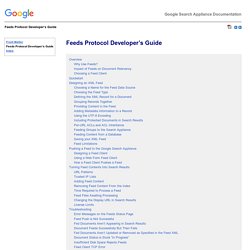
To push content to the search appliance, you need a feed and a feed client: This document explains how feeds work and shows you how to write a basic feed client. Back to top Overview You can use feeds to push data into the index on the search appliance. The search appliance does not support indexing compressed files sent in content feeds. The search appliance follows links from a content-fed document, as long as the links match URL patterns added under Follow and Crawl Only URLs with the Following Patterns on the Content Sources > Web Crawl > Start and Block URLs page in the Admin Console. Feeding Search Engines To Rise in Rankings. Search Engine Optimization or SEO.
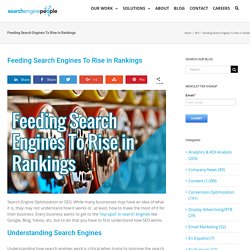
While many businesses may have an idea of what it is, they may not understand how it works or, at least, how to make the most of it for their business. Every business wants to get to the 'top spot' in search engines like Google, Bing, Yahoo, etc. but to do that you have to first understand how SEO works. Web Crawling: Data Scraping vs. Data Crawling. One of our favourite quotes has been- ‘If a problem changes by an order, it becomes a totally different problem’ and in this lies the answer to- what’s the difference between scraping and crawling?
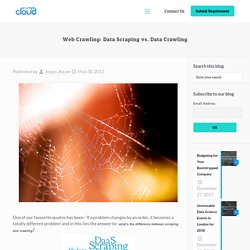
Crawling usually refers to dealing with large data-sets where you develop your own crawlers (or bots) which crawl to the deepest of the web pages. Data scraping on the other hand refers to retrieving information from any source (not necessarily the web). 7.4 - Crawling and Indexing. After the Google Search Appliance has been set up (see Setting Up a Search Appliance), you can configure the search appliance to crawl the content sources that you identified during the planning phase, as described in Planning.

Crawl is the process by which the Google Search Appliance discovers enterprise content and creates a master index. The resulting index consists of all of the words, phrases, and meta-data in the crawled documents. When users search for information, their queries are executed against the index rather than the actual documents. Searching against content that is already indexed in the appliance is not interrupted, even as new content continues to be indexed.
Search engine - What is the difference between web-crawling and web-scraping? How Internet Search Engines Work. The good news about the Internet and its most visible component, the World Wide Web, is that there are hundreds of millions of pages available, waiting to present information on an amazing variety of topics.
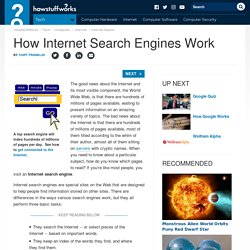
The bad news about the Internet is that there are hundreds of millions of pages available, most of them titled according to the whim of their author, almost all of them sitting on servers with cryptic names. When you need to know about a particular subject, how do you know which pages to read? מנוע החיפוש של אי.בי.אם. מנועי-חיפוש. אינדקסים לעומת מנועי חיפוש. כלי החיפוש באינטרנט נחלקים לשני סוגים עיקריים : א.

"מנועי חיפוש אוטומטיים" ב. אינדקסים אשר נבנים בצורה ידנית. א. מנועי החיפוש האוטמאטיים אוספים את הנתונים בעזרת "תוכנות שיטוט ואיסוף"' , תוכנות יעודיות אלו ידועות בספרות המקצועית לעתים גם בשם ( Crawlers ) הסורקות את אתרי האינטרנט ועוברות מדף לדף ומאתר לאתר (דרך הקישורים). הן יוצרות קובץ גדול מאוד של מאות מיליוני דפים שעברו אינדוקס אוטמאטי ע"י תוכנה. אף לא אחד ממנועי החיפוש מכסה את כל האינטרנט (מעל 40 מיליארד דפים),מנועי החיפוש האוטמטיים הגדולים שבהם (כגון גוגל ) מכסים רק 50 אחוזים מהדפים. ב. כלי עזר למיפוי מידע /ארגון מידע הכוללים מידע שיטתי שנאסף על ידי אנשים או מידענים שמקטלגים באופן ידני את האתרים תחת "עץ קטגוריות" ומספקים תיאור קצר או איפיון קצר לכל אתר שנוסף לעץ הקטגוריות ( או "עץ-הנושאים" ).
באינדקסים של אתרים אפשר גם לבצע חיפוש לפי מילות חיפוש , אך צריך לזכור שהחיפוש מתבצע על שמות הקטגוריות, האתרים או התיאור שלהם ולא על התכנים בתוך האתר. דוגמאות מעודכנות של אינדקסים , נובמבר 2014. מתחת למכסה המנוע : אסטרטגיות חיפוש מידע באינטרנט ובמאגרי מידע. ליקט וערך : עמי סלנט , גרסה 4 , ספטמבר 2016.

Web search engine - Wikipedia. Software system that is designed to search for information on the World Wide Web The results of a search for the term "lunar eclipse" in a web-based image search engine A web search engine or Internet search engine is a software system that is designed to carry out web search (Internet search), which means to search the World Wide Web in a systematic way for particular information specified in a textual web search query.
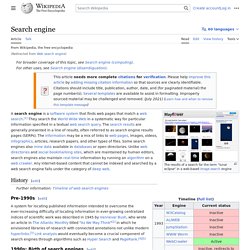
The search results are generally presented in a line of results, often referred to as search engine results pages (SERPs). The information may be a mix of links to web pages, images, videos, infographics, articles, research papers, and other types of files. Some search engines also mine data available in databases or open directories. History[edit] Internet search engines themselves predate the debut of the Web in December 1990. Prior to September 1993, the World Wide Web was entirely indexed by hand. By 2000, Yahoo! Approach[edit] Market share[edit] Europe[edit] [edit] Zoom Website Search Engine - Add search to a website, intranet or CD. V7.1 is now released with 12x increased indexing capacity and up to 5x performance gain!

Read more here. Zoom V7 is the most powerful version of Zoom yet. Featuring autocomplete search box, date range searching, URL indexing, search by site, greater customizability, an overhauled interface, SSL and HTTPS spidering indexing support and indexing support for additional file formats. This is the most powerful version of Zoom yet.
Semantic Search. Visualizing Logs Using ElasticSearch, Logstash and Kibana. Elasticsearch Tutorial & Getting Started (course preview) Building a Search Engine. Introduction - CS101 - Udacity. Apache Lucene - Welcome to Apache Lucene. Elasticsearch: Getting Started. Elasticsearch is on a mission to organize data and make it easily accessible.

In this webinar, we plan to provide a solid foundation on using Elasticsearch. By the end of the webinar, you should have an understanding of what Elasticsearch is capable of, how to implement basic functionality, and where to find more resources. Hosted Elasticsearch with Elastic Cloud 14 day trial. This webinar will cover: Downloading, prerequisites, and running Elasticsearch Adding, updating, retrieving and deleting data through CRUD REST APIs Basic text analysis, including tokenization and filtering Basic search queries Aggregations: the faceting and analytics workhorse of Elasticsearch Additional Resources: Running an older version of Elasticsearch? Watch Getting Started with Elasticsearch 1.7. Open Source Search & Analytics · Elasticsearch.
SEO For Dummies: Search Engine Optimization and Marketing For Dummies PDF. Introduction to Search Engine Optimization - University of California, Davis. A brief introduction to Search Engines. Search Engines- Helping us since ages! There are thousands of millions of pages on the web, all ready to present the information on a variety of interesting and amusing topics. The Search Engines are the messengers of the same information at your disposal whenever you need them. Well, the bad news is that there are thousands of millions of pages ready to fool you with inaccurate information shaped by the whim and fancy of the author. In this scenario, Search Engines are the saviours, who prevent these fraud websites/content from reaching out to you.